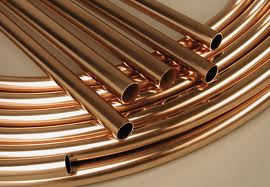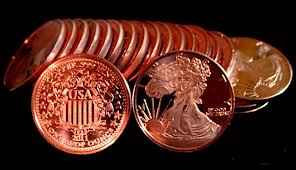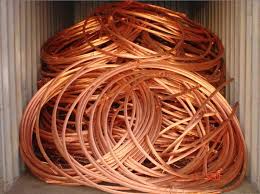

| Symbol: | Cu |
| Melting point: | 1,085'C |
| Electron configuration: | [Ar]3d104s1 |
| Atomic number: | 29 |
| Atomic mass: | 63.546±0.003u |



| Ore | Common Name | Formula |
|---|---|---|
| Oxide | Cuprite | Cu2O |
| Tenorite | CuO | |
| Sulphide | Chalcopyrite | CuFeS2 |
| Chalcocite | Cu2S | |
| Bornite | Cu5FeS4 | |
| Tetrahedrite | (CuFe)12Sb4S13 | |
| Ternatite | (CuFe)12As4S13 | |
| Famatinite | Cu3SbS4 | |
| Enargite | Cu3AsS4 | |
| Sulphate | Chalcanthite | CuSO4.5H2O |
| Carbonate | Malachite | Cu2CO3(OH)2 |
| Azurite | Cu3(CO3)2(OH)2 | |
| Silicite | Dioptase | CuSiO3.H2O |
| Chrysocolla | CuSiO3.2H2O | |
| Chloride | Alacamite | Cu2(OH)3Cl |
Copper is the first useful metal utilized by human being. It is easily distinguished from all other metal on account of its red color. Copper is found in metallic state in small quantities. It is readily shaped into ornaments, utensils, implements, statues and coins. It is the initial alloy forming metal when smelting of ores containing copper and its associate elements was carried out. Bronze was produced in Cornwall in U.K by accidental smelting of ores containing tin and copper in the camp fire. It is mentioned that copper is used by the ancient Egyptians. Then its use spread to other parts of the world. Major copper producing countries are U.S.A, Chile, Canada, Zambia, Zaire, Russia, Peru, Poland, Yugoslavia, China, Australia and India. A large part of the world production in copper is used in the electrical industry. Copper has very high specific conductivity. It has moderate tensile strength. It is highly malleable and ductile. It is very suitable for hot and cold working. Copper and its alloys are used in machinery and chemical industry. The alloys like brass and bronze have wide applications in chemical industries. Major sources of copper are native copper, chalcopyrite, chalcocite, pyrite, malachite & azurite.
ALLOYS OF COPPER
The alloys of copper are used in electrical wires, machineries and equipments having corrosion resistance. The copper based alloys possess greater strength and hardness. These alloys show great ductility and strength. The process of age hardening can increase the strength and hardness of some copper alloys. The strength and hardness is increased by addition of alloying elements. The casting properties are better in copper alloys but the electrical conductivity remains unchanged. Copper has two main alloys as brass and bronze. Brass is an essential alloy of copper and zinc. When zinc is up to 36%, it is known as alpha brass. When the zinc percentage is between 36-46.6%, the alloy is called alpha-beta-brass. Alloys with 46.6-50.6% of zinc are known as beta-brass. When the zinc is more than 50.6%, it is known as gamma-brass. Bronze contains 10% of tin with copper. Bronze is widely used as anti- friction material. When phosphorus is added, the alloying material is known as phosphorus bronze. It is used for electrical contact, bushing and clutch disks. Choosing an alloy for various applications is very difficult. But bronze has versatile character and wide ranging applications. Bronze is used in bearings and containers of under-water workings.
Wrought chromium bronze is used in grinding spindle. It is also used in valve guides for engines. Aluminium bronze shows high corrosion resistance. It is used in valve stems, bolts, nuts, condensers tubes, plates and pressure vessels. Copper Silicon alloy are called silicon bronzes. These alloys have silicon up to 4.0%. Small addition of manganese, iron and zinc help in increasing the corrosion resistance with high strength and toughness. These alloys are used in strips, plates, wires, rods, tubes, bolts, rivets, springs and propeller shafts. Copper Beryllium alloy is known as beryllium bronze. This alloy has high strength, hardness, and corrosion resistance, fatigue resistance and wear resistance.
Beryllium bronzes are used in springs, tubes, bearings, gears, flexible bellows, electrical contacts, hammers and tools. These are also used in firing pins and surgical instruments. The Copper-Nickel alloys have nickel up to 30% along with copper. The corrosion resistance increases with the increase of nickel contents. The color of the alloy becomes white this alloy is sensitive to oxygen, lead, sulphur and carbon. Small amount of iron and manganese makes the alloy resistant to sea water corrosion. It was wide applications in ships and sea water works. When chromium is added up to 0.5% copper chromium alloy is formed. It is used in electrical switches and gears. Zirconium is added up to 0.2% to form Zirconium-Copper alloy. Titanium is added up to 4% to form titanium copper alloy. These alloys are used in tools, springs and electrical contacts.
The copper alloys are also formed by addition of silver and gold. These alloys show high polish and good resistance to corrosion. These are used in makings of ornaments, buttons, emblems and trophies.